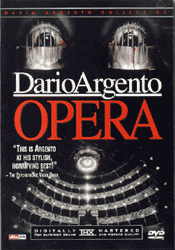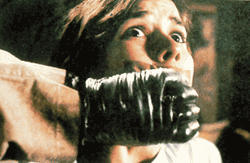Opera: Argento’s Ode to Beauty and Cruelty 
Opera, DVD released 2001 by Anchor Bay Entertainment
unrated, 107 minutes, color, widescreen (2.35:1 aspect ratio) enhanced for 16x9 TVs, THX digitally mastered, Dolby surround sound with DTS track, includes theatrical trailer, 36-minute “making of” documentary, music video by Daemonia, text biography of Dario Argento. Suggested retail price: $24.98.
* * *
 Dario Argento is famous in Italy, a cult figure in the United States. His reputation here rests on a series of 1970s and 1980s horror films, shockers marked by virtuoso directorial flourishes and disturbing brutality. His best known film here is probably Suspiria, a 1977 production that pushed the genre’s limits on sadism and surrealism. Suspiria is ostensibly about a young American woman lured to a ballet school where she gradually discovers an infestation of witches. Its real subject is not dance, or witches, but Argento’s own grotesque imagination, his lovingly detailed depictions of murder and weird visual asides punctuated by blasts of hard rock music. Tremendously influential in its time among horror fans and filmmakers, it’s still a memorable experience, if the shocks are somewhat dated.
Dario Argento is famous in Italy, a cult figure in the United States. His reputation here rests on a series of 1970s and 1980s horror films, shockers marked by virtuoso directorial flourishes and disturbing brutality. His best known film here is probably Suspiria, a 1977 production that pushed the genre’s limits on sadism and surrealism. Suspiria is ostensibly about a young American woman lured to a ballet school where she gradually discovers an infestation of witches. Its real subject is not dance, or witches, but Argento’s own grotesque imagination, his lovingly detailed depictions of murder and weird visual asides punctuated by blasts of hard rock music. Tremendously influential in its time among horror fans and filmmakers, it’s still a memorable experience, if the shocks are somewhat dated.
Four films later, Argento turned to an old standby of Italian horror, the serial killing story or giallo, for Opera (1987). Any horror film set in an opera house must pay homage to that tale of alienation and obsession, The Phantom of the Opera. In Opera, Argento doesn’t revive that story so much as rewrite it. The original Phantom wanted his diva to become a great singer; Argento’s masked fanatic has a more complicated agenda: to force a young singer to share his experience as he kills her friends in various inefficient but picturesque ways. Apparently—and this part gets a bit muddled in flashbacks—this hooded killer had a twisted sexual relationship with the young singer’s mother and is trying to indoctrinate a new generation. Meanwhile, the singer’s debut is overshadowing an older diva who’s playing theater politics, a flock of ravens (or are they crows?) has issues of its own, and a desultory search is going on for the killer, who keeps dicing up key backstage personnel without affecting the show, somehow.
So, along with the inevitable Phantom baggage, this film adds its own subtexts: voyeurism, emotional impotence, and the persistence of the past. Not that Argento probes deeply into any of these themes. As always, his first priority is to move quickly between several elaborate set pieces, which range in effect from stunning to merely strange.
The opening shows genuine wit, focusing on the squawking of a restless raven while in the background a touchy soprano tries to concentrate on her aria. The first voyeuristic murder is truly disturbing, primarily because the killer forces the heroine to watch by tying her up and taping rows of pins under her eyes to keep her from blinking. There are also some creepy moments in an escape through an old air duct led by a little girl.
On the other hand, there are choices that just don’t work, most notably the drawn-out multiple climaxes—in a film named Opera, why add an epilogue that takes place nowhere near the opera house? For that matter, why not score the film with operatic music, instead of hiring electronic pop composers for atmosphere and heavy metal rockers for the murder sequences?
 Argento is prone to other indulgences, typically involving camera point of view. Early in the film the camera assumes the perspective of the diva leaving the theater—and apparently she has eyes in the back of her head. There’s a cheat shot that builds suspense as someone approaches the heroine’s bedroom, but it turns out to be a friend. And there’s a swooping raven-cam shot that I guess is supposed to represent the director’s bravado, but looks like excess. Argento says that every one of these choices has some meaning beyond mere flash, but sometimes his intent escapes me. Not that I mind a bit of showmanship, of course. Even when his imagery is distracting, it’s at least entertaining, and often beautiful.
Argento is prone to other indulgences, typically involving camera point of view. Early in the film the camera assumes the perspective of the diva leaving the theater—and apparently she has eyes in the back of her head. There’s a cheat shot that builds suspense as someone approaches the heroine’s bedroom, but it turns out to be a friend. And there’s a swooping raven-cam shot that I guess is supposed to represent the director’s bravado, but looks like excess. Argento says that every one of these choices has some meaning beyond mere flash, but sometimes his intent escapes me. Not that I mind a bit of showmanship, of course. Even when his imagery is distracting, it’s at least entertaining, and often beautiful.
Ronnie Taylor, a fine cinematographer, does a great job of executing what were surely demanding requests from the director, and performs some feats of his own in lighting the huge theater and the claustrophobic living spaces. The acting is generally good, or at least un-self-conscious, throughout the film; Cristina Marsillach is an appropriate Argento protagonist, and co-star John Charleson, most famously featured in Chariots of Fire, shows some verve. American audiences may be put off by the Italian custom of shooting silent and sloppily dubbing all dialogue later, especially since most of the actors appear to be speaking English.
In the script, much is made of the fact that this opera company is staging Verdi’s Macbeth, which has the reputation of conferring bad luck on anyone producing it. Argento’s Opera has something of a hard-luck history of its own: accidents during filming, the death of Argento’s father in the course of production, and over all, the shadow of AIDS in the first flowering of that pandemic. (Argento, in the documentary that supplements this DVD, and in other interviews, says this film’s depiction of loveless or frustrated relationships is a result of his trauma over the death of friends from AIDS.) The curse apparently followed the film to a new format. Anchor Bay’s first issue of the DVD was on Sept. 11, 2001—not a fortuitous date for a publicity campaign—and soon buyers began complaining that the disk would not play, or was skipping chapters, forcing a recall.
The good, second issue disk comes in a case with a sticker that says “version 2.0.” It presents this film, previously released in the U.S. in a censored version as Terror at the Opera, in an uncut and uncensored form seen here for the first time. It’s a fine transfer, as good looking as anything I’ve put on my player lately, with appropriately rich sound. The accompanying documentary covers the background and production nicely, with substantial contributions by the director and his frequent collaborator, Daria Nicolodi. Fans of the gore subgenre will probably be pleased; others with a serious interest in the wide field of Italian horror, or in the preoccupations of one of the field’s masters, will find this DVD worth study.
